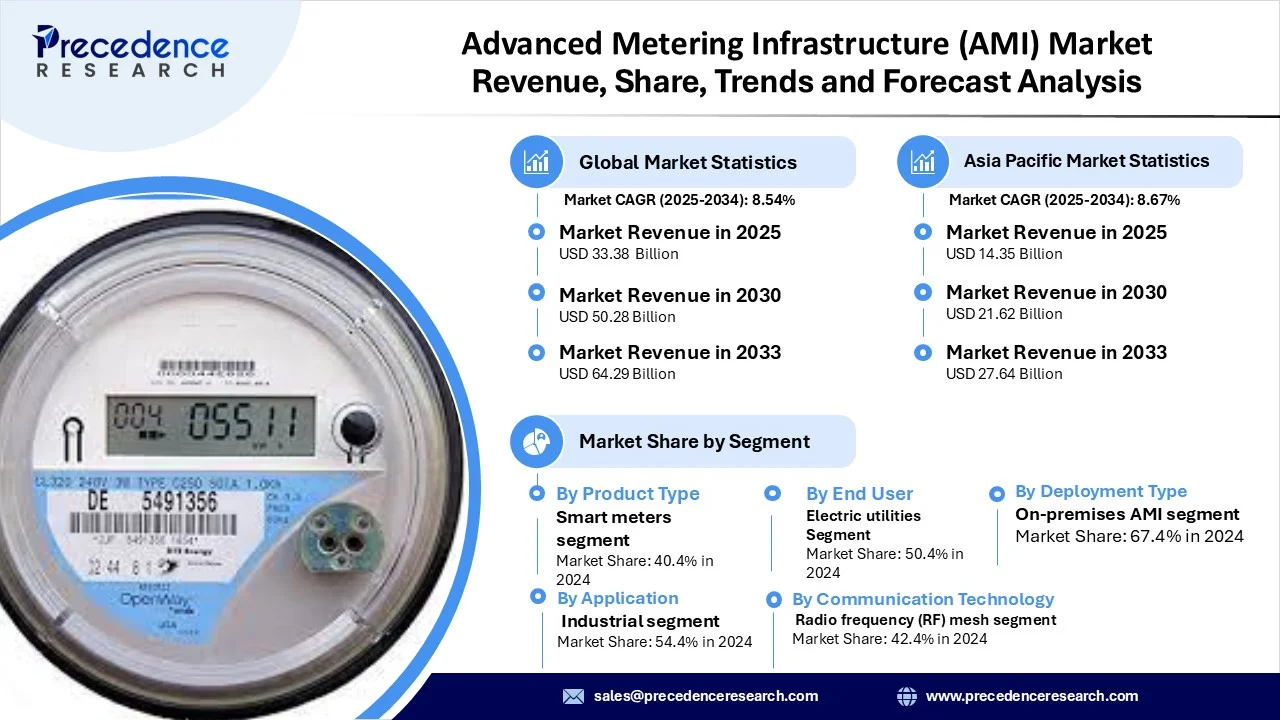Advanced Metering Infrastructure (AMI) Market Revenue to Attain USD 64.29 Bn by 2033
Advanced Metering Infrastructure (AMI) Market Revenue and Trends 2025 to 2033
The global advanced metering infrastructure (AMI) market revenue reached USD 33.38 billion in 2025 and is predicted to attain around USD 64.29 billion by 2033 with a CAGR of 8.54%. The market growth is driven by widespread adoption of smart metering devices, communication infrastructure like RF mesh and cellular networks, and sophisticated software solutions such as Meter Data Management Systems.

Advanced Metering Infrastructure (AMI) Market: Key Drivers & Emerging Opportunities
Advanced metering infrastructure (AMI) is a comprehensive system that combines smart meters, communication networks, and data management systems to facilitate two-way communication between utilities and their customers. The market for AMI is being driven by government mandates for smart meter implementations, an increasing focus on energy efficiency, and the urgent need to modernize aging grid infrastructure. Regulatory bodies across the globe are actively promoting AMI to help reduce carbon emissions and optimize energy usage. Utilities are adopting AMI to enhance grid resilience, enable faster outage detection, and incorporate distributed energy resources such as solar power and electric vehicles. Moreover, advancements in technology, including the integration of IoT, AI, and big data analytics, are improving system capabilities and data security.
Segment Insights
- By product type, the smart meters segment led the market, as smart meters form the essential hardware for the entire AMI ecosystem, enabling core functionalities that drive efficiency, cost savings, and grid modernization for both utilities and consumers.
- By end-user, the electric utilities segment dominated the market because utilities are the primary operators and main beneficiaries of the essential AMI functionalities, crucial for modernizing the electrical grid and enhancing operational efficiency.
- By deployment type, the on-premises segment is the market leader, as utilities prioritize control, security, and integration with existing legacy systems to ensure that sensitive customer data and critical operational technologies are within their own secure network boundaries.
- By application, the industrial segment held market dominance due to the significant financial incentives for large-scale energy optimization, the need for precise operational monitoring, and the considerable potential for cost reduction and efficiency improvements.
- By communication technology, the radio frequency (RF) mesh segment has taken the lead in the market due to its exceptional reliability, scalability, and cost-effectiveness, stemming from a decentralized and self-healing network architecture.
Regional Insights
Asia-Pacific region is the market leader and is expected to continue its growth during the forecast period, primarily driven by countries like China, India, Japan, and South Korea. This dominance is further propelled by rapid urbanization and industrialization, which are creating an increasing demand for electricity and efficient grid management. Additionally, the Asia-Pacific region is a hub for technological innovation, quickly embracing and integrating emerging digital technologies such as IoT, AI, and big data analytics into AMI systems. This focus aimed functionality and cost-effectiveness, strategically addressing grid modernization, renewable energy integration, energy efficiency, and the prevention of power theft.
Advanced Metering Infrastructure (AMI) Market Coverage
| Report Attribute | Key Statistics |
| Market Revenue in 2025 | USD 33.38 Billion |
| Market Revenue by 2033 | USD 64.29 Billion |
| CAGR from 2025 to 2033 | 8.54% |
| Quantitative Units | Revenue in USD million/billion, Volume in units |
| Largest Market | Asia Pacific |
| Base Year | 2024 |
| Regions Covered | North America, Europe, Asia-Pacific, Latin America, and the Middle East & Africa |
Recent Development
- In February 2024, GE Vernova launched GridOS® Data Fabric, the first data fabric specifically designed for grid orchestration. This innovation aims to help utilities operate smarter grids as renewable energy scales and improve resilience in the face of extreme weather events, allowing grid operators to discover, manage, and utilize vast amounts of highly distributed data, enabling faster and better decision-making while orchestrating the grid in real-time. (Source: https://www.gevernova.com)
Get this report to explore global market size, share, CAGR, and trends, featuring detailed segmental analysis and an insightful competitive landscape overview @ https://www.precedenceresearch.com/sample/7006
You can place an order or ask any questions, please feel free to contact us at sales@precedenceresearch.com |+1 804 441 9344